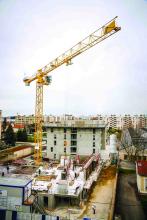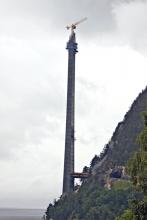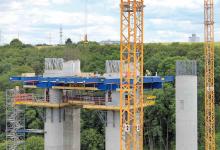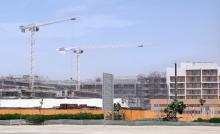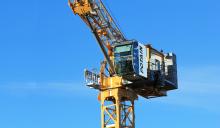Crane manufacturer Manitowoc has supplied six Potain cranes to German contractor Max Bögl. These machines are being used for constructing a new bridge carrying the A3 autobahn, close to Limburg. Working at over 70m high, the cranes tower over the Lahn Valley.
The cranes for this project were supplied by Max Bögl’s subsidiary, Max Bögl Transport & Geräte. The three topless Potain MDT 222 cranes were selected for the work as they feature tip heights of up to 76.2m and can operate with a working radius of
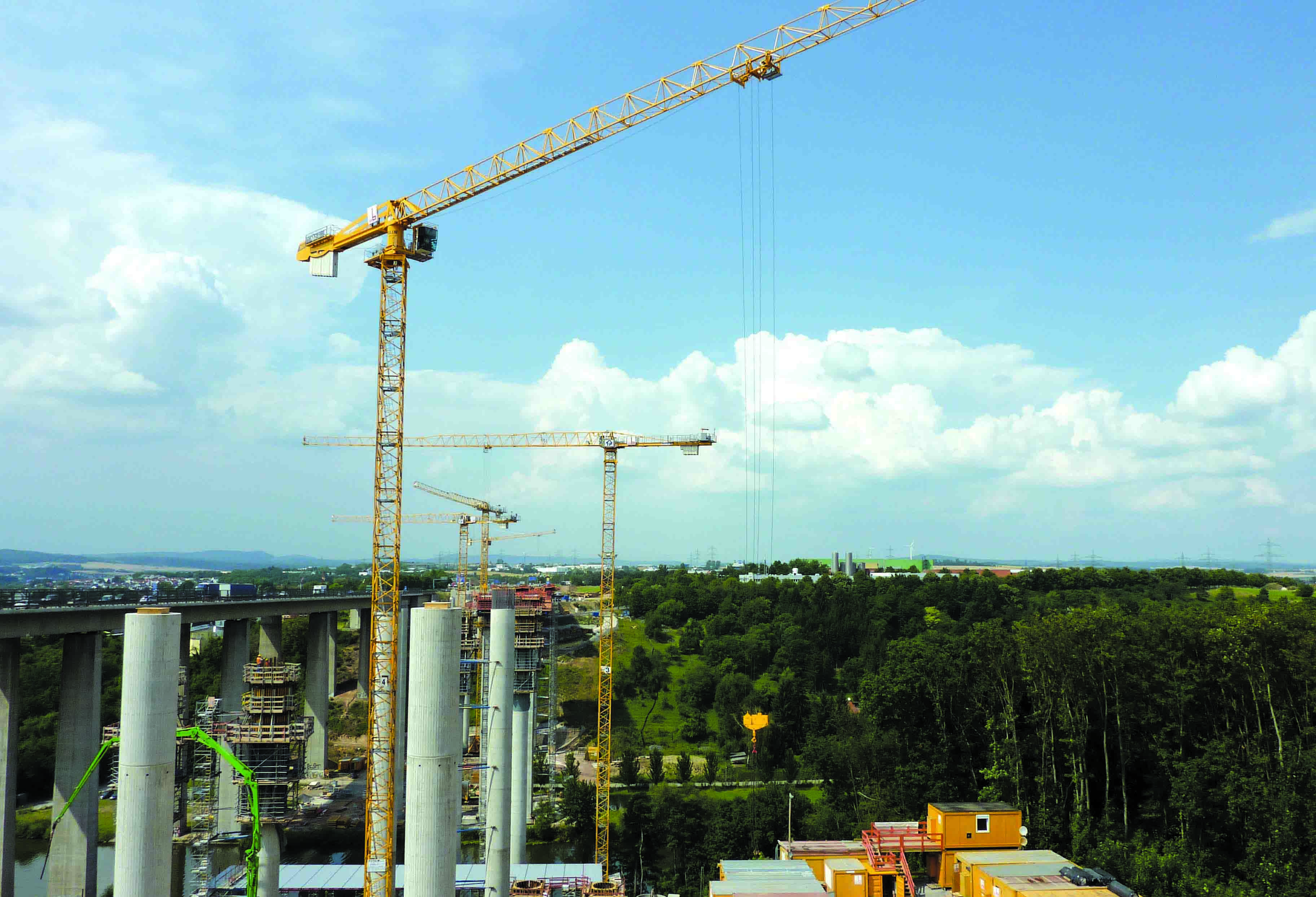
The Manitowoc cranes have proven productive in the bridge construction project
Crane manufacturer Manitowoc has supplied six Potain cranes to German contractor Max Bögl. These machines are being used for constructing a new bridge carrying the A3 autobahn, close to Limburg. Working at over 70m high, the cranes tower over the Lahn Valley.
The cranes for this project were supplied by Max Bögl’s subsidiary, Max Bögl Transport & Geräte. The three topless5916 Potain MDT 222 cranes were selected for the work as they feature tip heights of up to 76.2m and can operate with a working radius of up to 60m where deployed. Two of the cranes are mobile while the third has been erected in a stationary configuration.
The contractor is using other Potain cranes also from its fleet; a stationary MD 150 with a tip height of 29.8m and radius of 55m and an MD 235 J12 with a tip height of 35.4m and a radius of 54.9m. In addition, a topless MDT 268A J12 with a tip height of 63.1m and a radius of 60m has been erected in moveable configuration and is being rented from2123 Manitowoc’s fleet for 15 months.
Enormous repair and maintenance costs necessitated the construction of the new Lahn Valley bridge, which involves rerouting the freeway. Additionally, the new structure will be designed with a noise barrier. The foundations of the new bridge are conventional bored pile foundations but the abutment head will be poured, so two auxiliary piers are needed. These will be erected by a slip form method next to the future structural piers and after completion of the abutment head, two shoring structures will be built on top.
The new track is being created step-by-step in both directions and every week 5m long track sections will be built, using the free cantilever method. As soon as the track towards Cologne has been completed, the Potain cranes and auxiliary piers will be shifted sideways for the same task, constructing the second bridge’s superstructure.
For the track towards Frankfurt, the cranes will be moved on a rail system. The auxiliary piers weighing almost 500tonnes on steel skidways and plain bearings, use a hydraulic shifting system.
"Due to the special job site conditions here with a busy freeway and a railway at the south shore, all cranes had to be equipped with an operating limit system,” said Herbert Wieseckl, department manager for structural engineering technology at Max Bögl Transport & Geräte.
Equipped with the powerful 75 LVF hoist, the Potain machines has been used to pour up to 18m³ of concrete/hour.
Selection of the crane specifications had to be taken into account because of the frame work weighing up to 8tonnes, which was supposed to be transferred across the Lahn River to the next crane. For the same reason, mounting heights allowing overlapping swivel movements had to be selected.
Deployment of the V63A undercarriage, a reinforced version of the V60, was necessary in order to achieve the free-standing tip heights and related capacities. Up to the first tower section, the V63A is higher than the V60, therefore it can handle 180tonnes of ballast instead of 132tonnes.
“At such tip heights, the load duty cycle performance is important,” said Manfred May, site manager in Limburg. “The cranes have been equipped with the high performance 75 LVF hoist and all cranes have a rescue system from heights. Each crane operator has been trained for this to ensure safety. Also, concrete pumps can only be used up to a certain construction height so some concreting work was done by the cranes. With Potain cranes, we could pour up to 18m³ of concrete an hour. That's quite an accomplishment.”
“Another important aspect of this construction site is the temperature, because now the authorities prohibit working at temperatures exceeding 38°C,” added May. Because of this the air-conditioned cabs of the cranes have come in useful.
The old Lahn Valley Bridge was built in 1964 and is about 400m long and almost 60m high, according to the Federal Highway Research Institute. Its daily traffic volume exceeds 100,000 vehicles, which makes this bridge one of the most heavily used bridges in Germany. The old Lahn River Bridge was beyond saving and after completion of the new bridge, the old structure will be demolished.
The cranes for this project were supplied by Max Bögl’s subsidiary, Max Bögl Transport & Geräte. The three topless
The contractor is using other Potain cranes also from its fleet; a stationary MD 150 with a tip height of 29.8m and radius of 55m and an MD 235 J12 with a tip height of 35.4m and a radius of 54.9m. In addition, a topless MDT 268A J12 with a tip height of 63.1m and a radius of 60m has been erected in moveable configuration and is being rented from
Enormous repair and maintenance costs necessitated the construction of the new Lahn Valley bridge, which involves rerouting the freeway. Additionally, the new structure will be designed with a noise barrier. The foundations of the new bridge are conventional bored pile foundations but the abutment head will be poured, so two auxiliary piers are needed. These will be erected by a slip form method next to the future structural piers and after completion of the abutment head, two shoring structures will be built on top.
The new track is being created step-by-step in both directions and every week 5m long track sections will be built, using the free cantilever method. As soon as the track towards Cologne has been completed, the Potain cranes and auxiliary piers will be shifted sideways for the same task, constructing the second bridge’s superstructure.
For the track towards Frankfurt, the cranes will be moved on a rail system. The auxiliary piers weighing almost 500tonnes on steel skidways and plain bearings, use a hydraulic shifting system.
"Due to the special job site conditions here with a busy freeway and a railway at the south shore, all cranes had to be equipped with an operating limit system,” said Herbert Wieseckl, department manager for structural engineering technology at Max Bögl Transport & Geräte.
Equipped with the powerful 75 LVF hoist, the Potain machines has been used to pour up to 18m³ of concrete/hour.
Selection of the crane specifications had to be taken into account because of the frame work weighing up to 8tonnes, which was supposed to be transferred across the Lahn River to the next crane. For the same reason, mounting heights allowing overlapping swivel movements had to be selected.
Deployment of the V63A undercarriage, a reinforced version of the V60, was necessary in order to achieve the free-standing tip heights and related capacities. Up to the first tower section, the V63A is higher than the V60, therefore it can handle 180tonnes of ballast instead of 132tonnes.
“At such tip heights, the load duty cycle performance is important,” said Manfred May, site manager in Limburg. “The cranes have been equipped with the high performance 75 LVF hoist and all cranes have a rescue system from heights. Each crane operator has been trained for this to ensure safety. Also, concrete pumps can only be used up to a certain construction height so some concreting work was done by the cranes. With Potain cranes, we could pour up to 18m³ of concrete an hour. That's quite an accomplishment.”
“Another important aspect of this construction site is the temperature, because now the authorities prohibit working at temperatures exceeding 38°C,” added May. Because of this the air-conditioned cabs of the cranes have come in useful.
The old Lahn Valley Bridge was built in 1964 and is about 400m long and almost 60m high, according to the Federal Highway Research Institute. Its daily traffic volume exceeds 100,000 vehicles, which makes this bridge one of the most heavily used bridges in Germany. The old Lahn River Bridge was beyond saving and after completion of the new bridge, the old structure will be demolished.


